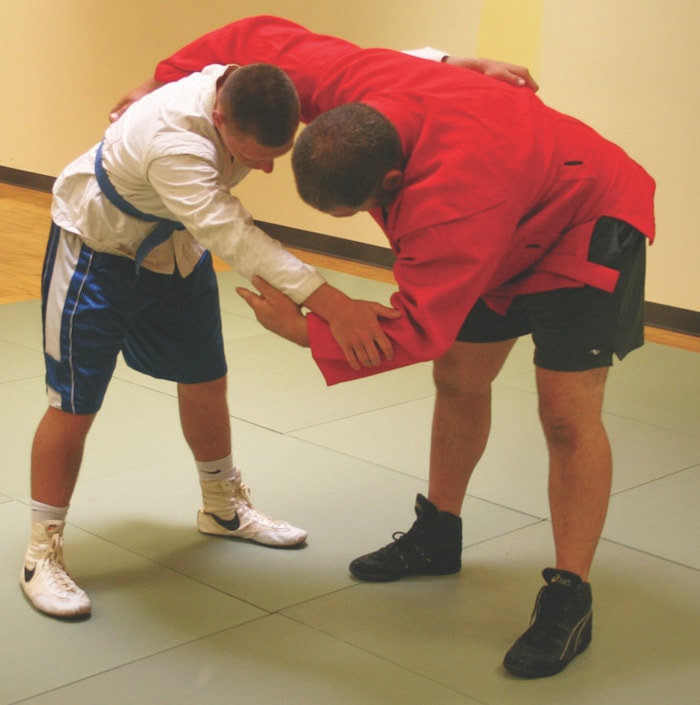To some mat officials, amplitude and force, or impetus, also counts in the equation, but not always. Sambo is actually a throwing and submission sport, with a throwing technique serving as a means to the end the match, and if that doesn’t happen, the throw can result in the attacker following through to the mat or ground and forcing an opponent to submit. And sambo matches start with both athletes standing and facing each other. Knowing how to skillfully and effectively throw an opponent to the mat is a vital part of sambo.
The development of sambo’s many technical skills, especially in throwing techniques, comes from a variety of sources, with the emphasis primarily coming from Kodokan judo of Japan, chida-oba of Georgia and kurash of Uzbekistan as well as other wrestling styles. More specifically, the biomechanical concepts of what makes a throwing technique work and work with a high rate of success in a functional way come directly from Vasili Oshpechkov’s study of judo in the early 1900s and the subsequent additions from the wrestling styles gleaned from the various Russian republics as well as the innovative ideas and practices by later generations of sambo exponents. These core mechanical skills apply to every throwing technique used in sambo, and while in many cases these specific skills blend in together in a rapid and explosive application, they are, indeed, all part of the total picture of how to effectively throw an opponent to the mat or ground.
It’s also important to remember that it requires two sambo wrestlers for a throw (or any technique) to happen. The attacker must control his opponent’s body, but he also must control his body as well. With this in mind, let’s analyze the core movements of what makes a throwing technique in sambo work. These are the sum parts that make the whole of a throwing technique.
Core Root of Sambo
To start, let’s look at the core root of sambo’s throwing mechanics that come from Kodokan judo. The three parts of every throw in Kodokan judo are: (1) kuzushi—controlling and unbalancing the opponent; (2) tsukuri—fitting into and building the technique; and (3) kake—executing the throw. Sambo’s approach to the analysis and synthesis of a throwing technique comes directly from Kodokan judo and is pretty much the same; however, there are other areas of emphasis taught at the core level that are important to point out.
So with this in mind, let’s analyze the parts of a throwing technique. If you’ve read my book on judo, The Judo Advantage, you will recognize the following underlying and foundational principles of a functional approach to throwing techniques.
It’s useful to consider a throwing technique as a weapon. The action of throwing another human being down to the ground or mat is a ballistic movement based on fundamentally sound principles of biomechanics. You can use it, and it can be used against you. It’s much like a gun in that sense. Like any other tool or weapon, it has no personality or life of its own and how you use it is up to you. If you go into a gunfight with a .22 caliber handgun and your opponent has a .44 Magnum, you may be in trouble. But, if you’re more willing to shoot and know how to shoot that .22 straighter, faster, and more accurately than your opponent does his .44 Magnum, you might come out the winner in that gunfight.
I compare the caliber of a gun’s bullet to the training you put into your throw. The more powerful the bullet combined with a rifled barrel on the gun means that gun will shoot with its full ballistic effect. If you’ve done your speed/strength training so that you have tremendous plyometric strength when performing the throw, then you have a .44 Magnum bullet. But if you haven’t put in the physical effort, then you’re only shooting a .22 caliber bullet. If you’ve gone to the shooting range and practiced both smart and hard, and know how to handle that handgun in realistic situations, then you’re most likely going to shoot both accurately and fast when in a real gunfight. But if you’ve only shot the gun a few times and not under realistic situations, then you’ll most likely not shoot very straight or fast enough when you need to. I think you get the analogy by now. It takes a combination of physical fitness training along with lots of serious training on the mat to have the explosive power and technical ability to throw an opponent in a real situation.
The following formula is one that I favor when describing what happens in every successful throw: P + M = C. P (position) combined with M (mobility or movement) results in C (control of your opponent). This is true for any phase of grappling or fighting but is especially true when it comes to throwing an opponent. You’re fighting someone who is on his feet and can move, and as a result can either attack you or defend against your attack. Your position and the position your opponent is in are vital to the execution of a successful throw or takedown. Often, how you move and how you make your opponent move dictate both your position and his position. You have controlled the situation and can effectively throw your opponent when you’ve been able to control both your opponent’s position and movement as well as your own. Now, how you go about doing that takes some study and a lot of hard work on the mat.
All the techniques of sambo are performance-based skills. In other words, the efficiency of the performance of any given technique is the primary judgment of success. “Style” points are not given, so the aesthetics of the throw are secondary to its effect. In essence, the effectiveness of the throw determines its aesthetic value. As former U.S. National Sambo Champion Shawn Watson remarked, “It’s only pretty if it works.” What this means, from a coaching point of view, is that the functional purpose of the technique is taken into account when any biomechanical skill is initially taught to an athlete. As the athlete increases his or her skill in the application of the fundamental technique, his or her coach quickly guides the athlete into making the move more efficient for that athlete personally.
Right from the start, the core and fundamental application of a move is taught so that it best works for the athlete doing it. The fundamental move is not altered so much that it fails to retain its purpose and effectiveness, but for example, a tall, slender athlete will learn a basic throw in a slightly different way than a short, stocky athlete will. While the specific fundamental throwing technique is the same, the people doing it are not, and a good coach (whether a sambo coach, or a coach of any sport) will make alterations and adjustments so that the technique being worked on best suits the purposes of the athlete doing it.
For instance, a basic hip throw looks pretty much the same no matter who does it, but for that hip throw to work best for a tall athlete, specific accommodations will have to be made. If the athlete learning the hip throw is short, the technique will be presented to him so that it works best for his specific physical attributes. In other words, the technique is altered to best work for the athlete doing it as opposed to a more “cookie cutter” approach. Not everyone is the same, so it makes more sense to teach (from a coaching point of view), learn (from an athlete’s point of view), and train in the most efficient way possible so the most effective results can be gained from the performance of the technique. Rather than an athlete fitting a throw, the throw fits the athlete. To the sambo exponents who developed the technical basis of the sport, the end result was the primary object. In other words, the form of the technical movement must be (first and foremost) functional, efficient and, taking it a step further, efficient with a high rate of success particular to the person doing it.
Building Blocks
While the original basis of sambo’s technical development, especially in throwing techniques, is based on Kodokan judo, heavy influences from (especially) chida-oba and kurash have formed the mechanical processes of sambo to a significant degree. Kodokan judo teaches the building blocks of kuzushi (unbalancing the opponent), tsukuri (building or fitting into the technique), and kake (execution of the technique). In some cases, a fourth element is taught: kime (finishing or following through with the technique) as separate but integrated elements of a throwing technique. Sambo does the same, but because of its technical background in other grappling sports in addition to judo, the building blocks often seem to blend together and in some cases may even be done at the same time so that the end result looks like a technique based on brute strength rather than what it is: a combination of physical fitness and efficient biomechanical application of movement, balance, speed, and control.
Another important thing to consider is that some techniques seem more natural to some people than others. We’re all different, and in many cases a particular throw or type of throw seems more “natural” to you than others. If this is the case, go with it and try to develop that throw so that it works for you in real situations. Give it a while and take the time to see if that throw is a good one for you. In the end, it may or may not be something you can use now, but you may keep it on the back burner and use it later in your career.
TECHNICAL TIP:Elite and world-class skills are fundamental skills that have been developed to their full potential. As he is learning the fundamental or core skills of a throwing technique (or for that matter, any technique, whether it’s a throw, submission technique, or hold-down), the sambo grappler will develop and adapt that move so that it fits him like a glove. As World Sambo Champion Maurice Allan once said, “Make the technique work for you.”
The above is an excerpt from The Sambo Encyclopedia: Comprehensive Throws, Holds, and Submission Techniques, by Steve Scott, Pub Date November 2019, by YMAA Publication Center, ISBN: 978-1-59439-655-7.




